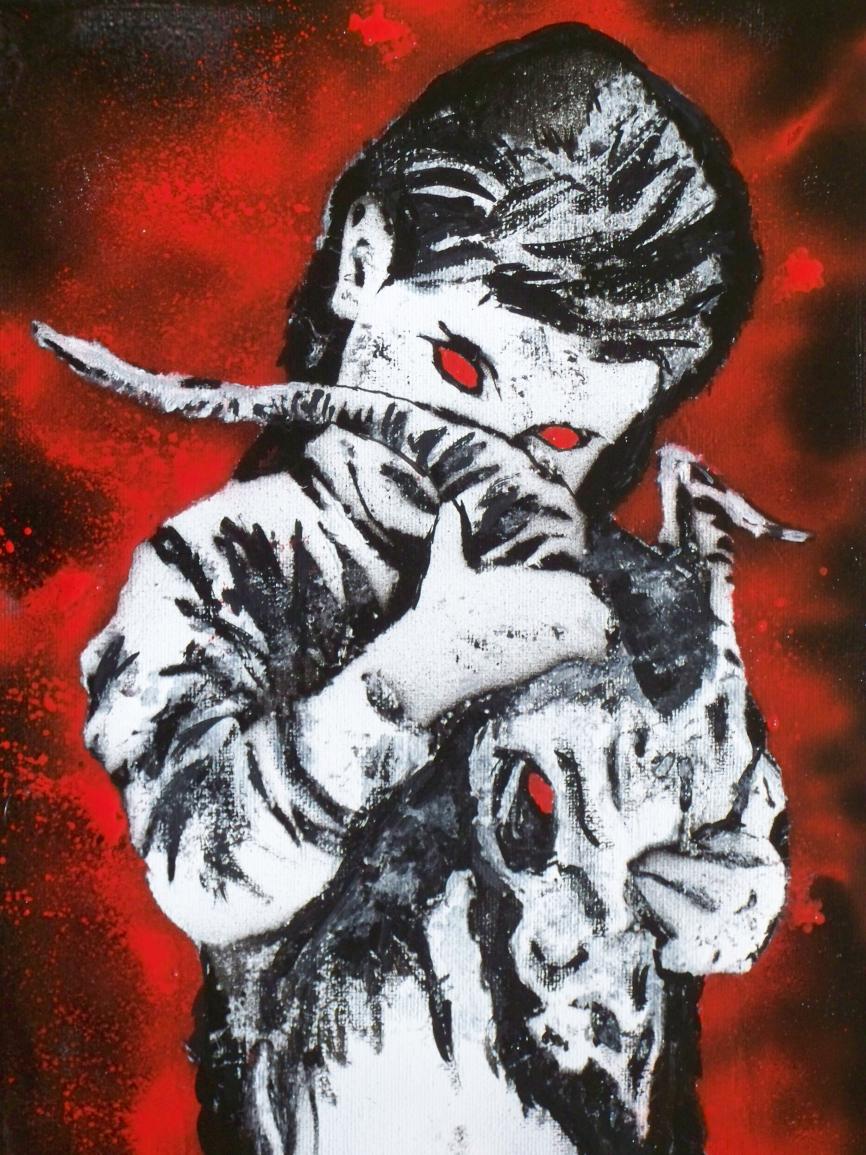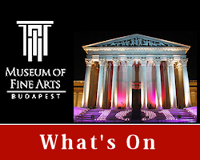Details
- 2013-02-16
- 0
- 163
- 2013
- Painting
- Aerosol Paint
- Religion
Pricing
Price and availability not indicated

- MESSE NOIRE -
Description by Mister 13
Aerosol spray and kleenex on canvas, 2 coffee, 3 cigarette. A Black Mass is a ceremony supposedly celebrated during the Witches' Sabbath, which was a sacrilegious parody of the Catholic Mass. Its main objective was the profanation of the host, although there is no agreement among authors on how hosts were obtained or profaned; the most common idea is that they were profaned by means of some ritual related to sexual practices. Authors also disagree on which rites were performed during the ceremony. Some medieval writers believed that the host was replaced by a toad, a turnip or a piece of dry flesh, but most judges and authors believed that true hosts were given by Christian priests, who had made diabolical pacts, to the attendants of the Sabbath to be profaned by them. Although the Black Mass is erroneously associated with witches and witchcraft it does play a distinct part in witchcraft history. During the middle ages and in the midst of the witch-hunt mania witches were accused of participating in these ceremonies. It is doubtful if any, but only a few witches, ever participated in the cerebrations. As it will be shown, the Black Mass was more of a ceremony that attracted the more wealthy and educated dissenters of the Church. The Black Mass has no association with modern Witchcraft because most Neo-Pagan Witches do not believe in the Devil or worshipping him. There is no set Black Mass ritual, rather the ceremony is a parody on the holy Catholic Mass. One ritual is that it is performed in entirety, or in parts, backwards. The Mass may include inverting the cross, spitting and stepping on the cross, stabbing the host and other obscenities. Urine, supposedly, was at various times substituted for holy water, or for the wine. Sliced pieces of rotted turnips, black leather, or black triangles were substituted for communion bread. Black candles were used instead of white ones. A defrocked generally performed the Black Mass wearing vestments of black or a color of dried blood, and embroidered with inverted crosses, a goat's head (referring to Baphomet), or magical symbols. The magical significance of the Black Mass rests in the belief that the Holy Mass involves the miracle of the transubstantiation, that is, the magical or mystical changing of the bread and wine into the body and blood of Jesus Christ. If the priest can affect this miracle within the Holy Mass, then, it is reasoned, the priest, or magician, could effect similar magic in other masses for other, usually harmful, purposes. The Catholic Church condemned priests who attempted to subvert the Holy Mass for evil purposes, such as cursing a person to death, as early as the 7th century. One such famous form of the Black Mass is The Mass of Saint-Secaire, which is said to have originated in the Middle Ages in Gascony. Its purpose was to curse an enemy to death by a slow illness, which wasted him away. Montague Summers renders a colorful description of it in The History of Witchcraft and Demonology. The origins of the current known versions of the Black Mass date back to the 14th century in France. This was the time when the Church was persecuting heretics.The Knights Templar, in particular, were accused of conducting these Masses and also other blasphemous rites in which they denounced Christ, worshipped idols composed of stuffed human heads, spit on and trampled the cross, and worshipped the Devil in the form of a black cat. Through accusations and trails the order was tumbled, but whether all the accusations were true still remains a mystery to many. The Catholic Church has regarded the Eucharist as its most important sacrament, going back to apostolic times. In general its various liturgies followed the outline of Liturgy of the Word, Offeratory, Liturgy of the Sacrament, and Benediction, which developed into what is known as the Mass. However, as early Christianity was becoming more established and growing in influence, the early Church fathers described a few heretical groups practicing their own versions of Masses, some of a bizarre sexual nature (such as among the Borborites). Another early description, containing many traditional details of the Black Mass, is found in Chapter 9 of the Christian apologetic work Octavius, written around 200 AD. There, a Roman pagan describes Christians as worshiping the head of an ass, sacrificing a baby for the Host, and having an orgy in a darkened room at the end of their rituals. The popularity for the celebration of Black Masses seemed to spread during the 15th and 16th centuries. In 1500 the cathedral chapter of Cambrai held Black Masses in protest against their bishop. A priest in Orleans, Gentien le Clerc, tried in 614-1615, confessed to performing the "Devil's mass" which was followed by drinking, and a wild sexual orgy. In 1647 the nuns of Louviers claimed that they had been bewitched and possessed, and forced by chaplains to participate naked in masses, defiling the cross and trampling the host. The peak for the Black Mass was reached in the 17th century during the reign of Louis XIV, who was accused of being lenient toward witches and sorcerers. It was the time when the Black Mass was extremely popular among the nobility, who thought its performance was exotic. Also, this was a time when the Church was becoming more stringent. The nobility still enjoyed indulging in the pleasures of life, which they considered sex still to be one of them. The Black Mass was a form of protest too. It became fashionable to have Black Masses said in dark cellars. The leading organizer of such events was Catherine Deshayes, known as "La Voisin," who was supposedly a witch that read fortunes and sold love philters. She was able to acquire priests, probably also protesting the Church, to say these blasphemous masses, including the infamous Abbé Guiborg, who wore gold-trimmed and lace-lined vestments and scarlet shoes. There was reportedly one notorious mass performed for the mistress of Louis XIV, the Marquise de Montespan. Montespan had sought the services of La Voisin to arrange the Black Mass because she thought the king was interested in another woman. While using Montespan as a naked alter, Guiborg said three Black Masses over her, invoking Satan and his demons of lust and deceit, Beelzebub, Asmodeus, and Astaroth, to grant Montespan whatever she desired. Supposedly while incense burned, the throats of children were cut, and their blood drained into chalices and mixed with flour to make the host. Whenever the mass called for kissing the altar, Guiborg kissed Montespan. He consecrated the host over her genitals, sticking pieces into her vagina. An orgy followed the ritual. The bodies of the children were later burned in the furnace of La Voisin's home. When the scandal broke 246 people were arrested by the king's order. Among them were some of France's highest-ranking nobility. They were brought to trial and confessions were gotten by means of torture. Most of the nobility receive jail sentences, or exile to the countryside. The thirty-six commoners were executed, including La Voisin who was burned alive in 1680. When reviewing the history of the Black Mass it is easily seen why many doubt that a large number of witches participated in them. The Black Mass, on the whole, was more of a protest of churchmen against the Church. The witches, as a group, of the time were already on the out with the Church. Many were desperately trying to save their lives, plus few fitted into the nobility. Perhaps La Voisin was a witch, but if she was, it appears she used her skills to better herself. She, most likely, could not be classified as an ordinary witch. Nevertheless, none of this was obvious to the witch-hunters and inquisitors. For them the Black Mass only served as another reason to go after witches. Likewise, confessions were tortured from witches that included tales of performing obscene rituals at sabbats such as defiling the cross while the Devil served as the priest. It is uncertain whether such accounts entailed the actual performance of the Black Mass. It is possible that some pagans retained their beliefs in face of the Church's opposition and did worship another god or the Devil as a way of fighting back. Possibly, they felt they had a friend in the Devil, for they knew they had no friend in the Church. During the 19th century the Black Mass went into further decline. A London fraternal group call the Hellfire Club, in the latter part of the century, was said to perform a Black Mass regularly to worship the Devil. Although, speculation is that the ritual was little more than sexual escapades with large quantities of alcohol. In 1947, a Black Mass was performed at the graveside of Aleister Crowley, who in life thought himself the Antichrist. When the Church of Satan was founded in 1966, the Black Mass was not included among its rituals because the founder, Anton Szandor LeVey, thought the Black Mass was outmoded. However, other satanic groups do conduct their versions of the Black Mass that include deviant sexual acts and orgies, necrophilia, cannibalisms of sacrificial victims (including human beings), and drinking the blood of the victims. A.G.H. In spite of the huge amount of French literature discussing the Black Mass (Messe Noire) at the end of the 19th century and early 20th century—no set of written instructions for performing one, from any purported group of Satanists, turned up in writing until the 1960s, and appeared not in France, but in the United States. As can be seen from these first Black Masses and Satanic Masses appearing in the U.S., the creators drew heavily from occult novelists such as Dennis Wheatley and Joris-Karl Huysmans, and from non-fiction occult writers popular in the 1960s, such as H. T. F. Rhodes (who provided a title in his 1954 book The Satanic Mass), and Grillot de Givry (author of the popular illustrated book Witchcraft, Magic and Alchemy). The Church of Satan began creating their own Black Masses, two of which are available to the public. The first, created for the Church of Satan by Wayne West in 1970, was entitled "Missa Solemnis" (originally published only in pamphlet form, later published in Michael Aquino's history of The Church of Satan, and the second, created by an unknown author, was entitled "Le Messe Noir" (published in Anton LaVey's 1972 book The Satanic Rituals). All of the Satanic Masses contain the Latin phrase "In nomine Dei nostri Satanas Luciferi Excelsi", as well as the phrases "Rege Satanas" and "Ave Satanas" (which, incidentally, are also the only three Latin phrases which appeared in the Church of Satan's 1968 recording, "The Satanic Mass"). Additionally, all three modify other Latin parts of the Roman Catholic Missal to make them into Satanic versions. The Church of Satan's two Black Masses also use the French text of the Black Mass in Huysmans' Là-Bas to a great extent. (West only uses the English translation, LaVey publishes also the original French). Thus, the Black Mass found in The Satanic Rituals is a combination of English, French, and Latin. The French sections that LaVey published were quotations from Huysmans's La Bas. The Latin of Melech and LaVey is based on the Roman Catholic Latin Missal, reworded so as to give it a Satanic meaning ( the Roman Mass starts "In nomine Patris, et Filii, et Spiritus Sancti, introibo ad altare Dei", while LaVey's version, printed in the Satanic Rituals, starts "In nomine magni dei nostri Satanas, introibo ad altare Domini Inferi"). There are a small amount of copyist and grammatical errors. For example, "dignum" from the Mass, is once incorrectly spelled "clignum", in the printed Satanic Rituals. Another example, also appearing once, is "laefificat" instead of "laetificat". One of the more obvious grammatical errors is "ego vos benedictio", "I bless you", which should have been "ego vos benedico". Another grammatical peculiarity, is that throughout his version of the Mass, LaVey does not decline the name Satanas, as is typically done in Latin if the endings are used, but uses only the one form of the word regardless of the case. Melech uses Satanus. "Satanas" as a name for Satan appears in some examples of Latin texts popularly associated with satanism and witchcraft, such as the middle age pact with the Devil supposedly written by Urbain Grandier. Both Black Masses end with the Latin expression "Ave, Satanas!" - "Welcome, Satan!" (expressing the opposite sentiments of the similar statement made by Jesus to Satan in the Latin Vulgate Bible (Latin Vulgate, Matthew 4:10),"Vade, Satanas!" - "Go away, Satan!"). "The usual assumption is that the Satanic ceremony or service is always called a black mass. A black mass is not the magical ceremony practiced by Satanists. The Satanist would only employ the use of a black mass as a form of psychodrama. Furthermore, a black mass does not necessarily imply that the performers of such are Satanists. A black mass is essentially a parody on the religious service of the Roman Catholic Church, but can be loosely applied to a satire on any religious ceremony". Anton Szandor LaVey







